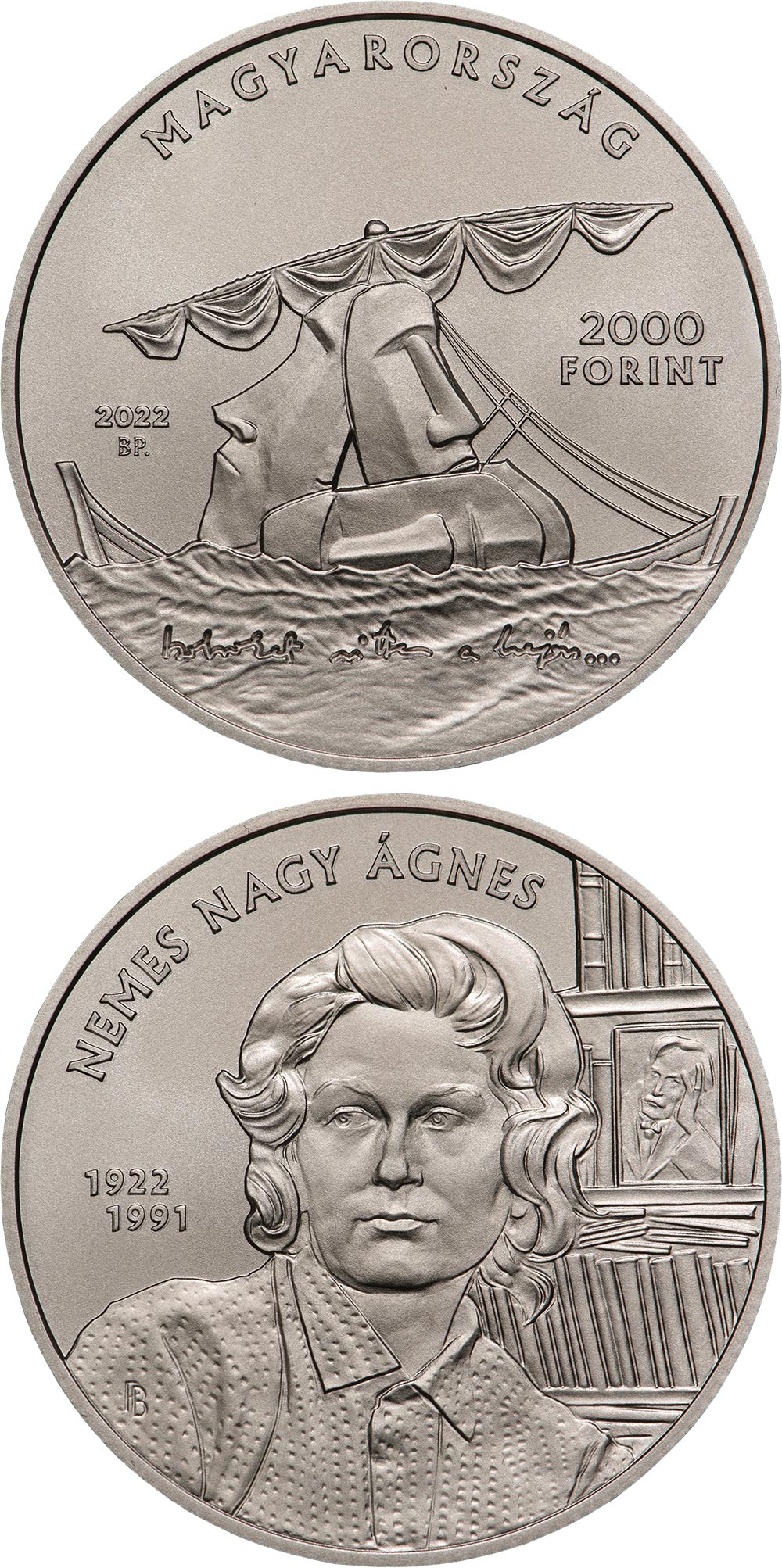2,000 forint - 100th anniversary of the birth of Ágnes Nemes Nagy
Series: Hungary - Commemorative 2000 forint coins

n the Day of Hungarian Poetry, on 11 April 2022, the Magyar Nemzeti Bank is issuing a silver collector coin with a face value of HUF 15,000 and a non-ferrous metal coin with a face value of HUF 2,000 to commemorate the 100th anniversary of the birth of Ágnes Nemes Nagy. The collector coin, created by drawing on the thematic expertise of the Petőfi Literary Museum, was designed by sculptor Balázs Pelcz.
Ágnes Nemes Nagy (1922-1991) was a Kossuth and József Attila Prize awarded poet, literary translator and essayist. She began publishing her works in magazines in 1945. Her first book of poetry came out in 1946. With her husband Balázs Lengyel, himself a writer and literary critic, she founded ‘Újhold?’ (New Moon), a literary periodical, in the same year. New Moon was intended to carry on the ideas of ‘Nyugat’ (The West) and to bring together a young generation of writers. During the years of hard dictatorship Ágnes Nemes Nagy was allowed to publish almost exclusively as a literary translator and an author of children’s literature.
Her second volume of poetry, titled ‘Szárazvillám’ (Heat Lightning), was published in 1957, and a third, titled ‘Napforduló’ (Solstice), in 1967. It was in the latter that she included her emblematic poem ‘Szobrokat vittem’ (Statues I Carried) in the cycle ‘Között’ (Between) at the beginning of the volume. In the following years she published three volumes of collected poems: ‘A lovak és az angyalok’ (The Horses and the Angels) in 1969; ‘Között’ (Between) in 1981; and ‘A Föld emlékei’ (Earth’s Souvenirs) in 1986. Ágnes Nemes Nagy is today acknowledged as a reformer of Hungarian prose poetry on account of her later great, block form verse.
Her essay work is just as important as her poetic output. Following in the footsteps of her masters Gábor Halász and Antal Szerb, she is regarded as the heir to the essay writing tradition of Babits. She placed the contemporary interpretation of Mihály Babits on a new foundation. With Balázs Lengyel they reanimated New Moon (New Moon Yearbook) in 1986, of which 12 volumes were published until the death of Ágnes Nemes Nagy.
Her first volume of poetry won her the Baumgarten Prize at a young age, in 1948. She was awarded the József Attila Prize for her first volume of collected poems in 1969 and then, in recognition of her life’s work, the Kossuth Prize in 1983. She and her husband were awarded the Yad Vashem honorary title of ‘Righteous Among the Nations’ for their life rescuing activities during World War II in 1997. From 1998 she has been posthumous member of the Hungarian Digital Literary Academy.
Today, the Magyar Nemzeti Bank is issuing a silver collector coin with a face value of HUF 15,000 and its non-ferrous metal version with a face value of HUF 2,000 to commemorate the 100th anniversary of the birth of Ágnes Nemes Nagy.
On the obverse, the visualisation of the poem Statues I Carried by Ágnes Nemes Nagy is featured as the central motif: a stylised representation of a sinking sailing ship with three giant head statues on her deck. The first line of the poem is inscribed on the surface of the water in the Kossuth Prize awarded poet’s handwriting. The poem, which is also featured on the poet’s gravestone, puts into words the central question of the entire poetic output of Ágnes Nemes Nagy: the dilemma faced by creative men, in bare phrases so characteristic of her poems, using the instrument of objectivity. The obverse also bears the inscription ‘MAGYARORSZÁG’ (Hungary) in a circular upper legend, the mint year ‘2022’ and the mint mark ‘BP.’, arranged in two lines below each other on the left, and the denominations ‘15000’ and ‘2000’ and the lettering ‘FORINT’ on the right.
The reverse of the coin bears a portrait of Ágnes Nemes Nagy, with her books in the background and a portrait of Mihály Babits, her literary example. The circular legend ‘NEMES NAGY ÁGNES’ is placed on the edge of the reverse, and the inscriptions ‘1922’ and ‘1991’, the years of the birth and death of Ágnes Nemes Nagy, broken in two lines on the left. The master mark of designer Balázs Pelcz is placed on the lower left side of the reverse, positioned on the portrait.